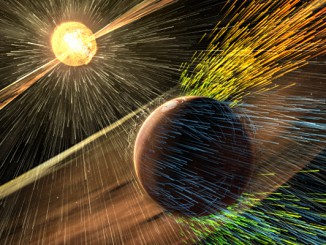
An ultra-sensitive French space agency seismometer carried to Mars by NASA’s InSight lander has detected a “marsquake,” the first such measurement in the history of Mars exploration.
The faint signal, captured by the Seismic Experiment for Interior Structure – SEIS – instrument, was recorded on 6 April, 128 days after InSight’s landing on the red planet. The signal appears to have been generated inside the planet and not by any surface-level phenomenon.
“We’ve been waiting months for a signal like this,” said Philippe Lognonné, SEIS team lead at the Institut de Physique du Globe de Paris (IPGP) in France. “It’s so exciting to finally have proof that Mars is still seismically active. We’re looking forward to sharing detailed results once we’ve had a chance to analyse them.”
Three other seismic events were detected on 14 March, 10 and 11 April, but they were much smaller and their origins more ambiguous.
InSight is equipped with two primary instruments: SEIS, provided by the French space agency CNES, and the Heat Flow and Physical Properties Package – HP3 – provided by the German aerospace agency. Both were placed on the surface of Mars by the lander’s robot arm. Three high frequency sensors used by the SEIS instrument were developed in the UK by Imperial College London, Oxford University and STFC RAL Space.
The HP3 instrument was designed to hammer its way into the martian soil, pulling temperature sensors along in its wake. The goal is to measure the thermal inertia of the soil and to help scientists extrapolate temperature profiles all the way to the core.
The heat flow instrument ran into a sub-surface obstruction of some sort shortly after it began digging into the soil and operations currently are on hold pending additional analysis. But the SEIS instrument appears to be operating normally.
And mission managers are thrilled.
“InSight’s first readings carry on the science that began with NASA’s Apollo missions,” said InSight Principal Investigator Bruce Banerdt of NASA’s Jet Propulsion Laboratory. “We’ve been collecting background noise up until now, but this first event officially kicks off a new field: Martian seismology.”
Said Charles Yana, SEIS mission operations manager at CNES: “We are delighted about this first achievement and are eager to make many similar measurements with SEIS in the years to come.”
Earthquakes are caused by the motion of tectonic plates along fault lines. Mars and the moon do not experience continental drift, but they still experience quakes caused by sub-surface cooling and contraction.
Apollo astronauts placed five seismometers on the moon in the 1960s and 1970s. By studying how seismic waves propagate through or reflect off different materials, scientists could map out the interior structure of the moon. They hope to do the same with Mars.
“The Martian Sol 128 event is exciting because its size and longer duration fit the profile of moonquakes detected on the lunar surface during the Apollo missions,” said Lori Glaze, Planetary Science Division director at NASA Headquarters.



